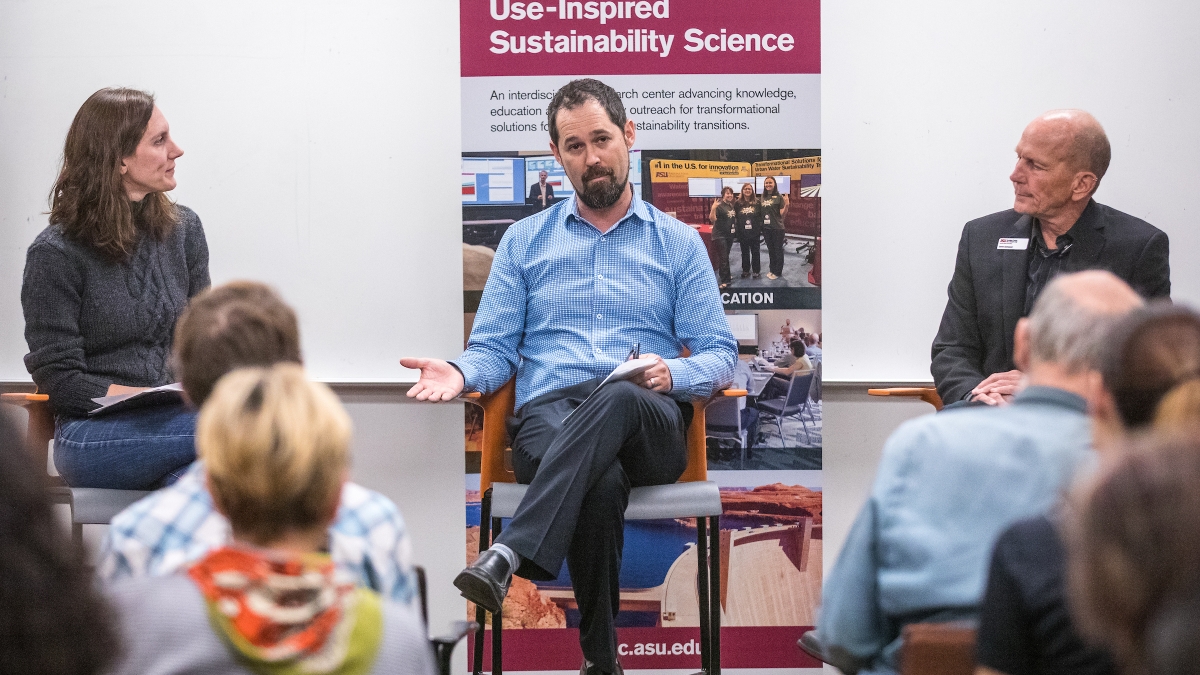Blessing the rains in Arizona: Can we use stormwater as a resource?
Water experts discussed the possibilities of turning stormwater runoff into a viable resource at an ASU panel on Wednesday

This past October saw the fourth-heaviest single rainfall in Phoenix history, right on the heels of a typically scorching summer. It topped up retention basins, was pumped off freeways, or simply flowed into the Salt River bed.
But is that stormwater a resource we’re letting run down the drain?
That was the question Wednesday at a panel discussion hosted by Arizona State University’s Decision Center for a Desert City.
Directing more stormwater toward permeable surfaces so it trickles down into the aquifers beneath the city and catching more in rain barrels at homes were some of the ideas discussed.
Multipurpose installations that collect water and can also be used as an amenity, like a park, or that protect from flooding while directing it towards aquifers are high on planners’ radars.
“Multipurpose use is something I feel strongly about,” said Harry Cooper, a landscape architect for the Maricopa County Flood Control District. He discussed a flood control project in the northwest Valley, where an aging concrete channel has been removed. It’s being replaced with an earthen channel which will shunt rain flow into catchment basins, where it will then settle and percolate into aquifers.
What would be some of the barriers to creating multipurpose rain-capture areas?
Maintenance, Cooper said. “It might not cost more (to perform),” he said. “It will just be different.”
And companies operating in the Salt River bed, such as rock and gravel operations, would not be receptive to creating a catchment operated as a public amenity, like a recreation area.
“I definitely think green stormwater infrastructure is key to heat adaptation,” said Maggie Messerschmidt, urban conservation program manager for the Nature Conservancy.
“What we need to be prepared for is all three: intense storms, flooding and heat adaptation,” she said. “How do we design for all three?”
County flood control is beginning to build above the mandated 100-year flood standard they’re required to meet, Cooper said.
“It may be just a few inches, but that could be the difference between a 100-year flood and a 500-year flood,” he said.
Stormwater could satisfy 6 percent of all outdoor water needs across the entire Phoenix metro area, said David Sampson, a systems analyst and process modeler for the Decision Center for a Desert City. The region gets anywhere from 1,000 acre feet to 20,000 acre feet of water per year. (An acre foot is enough water to cover an acre a foot deep. The rule of thumb is half an acre foot per household per year.)
Runoff collected in rain barrels at homes “might become a small supply,” Sampson said. “It’s in the realm of supplementing our water demand.”
Water in neighborhood retention basins after storms is an overlooked potential resource. Currently that water evaporates and percolates into the aquifer.
“Can we use that in another way?” Cooper asked.
The discussion was part of the center’s Water/Climate Briefings, held on a regular basis. These briefings are a regular forum for the water-policy community, DCDC researchers and students to exchange knowledge and ideas.
Above photo: Panelists Maggie Messerschmidt (left) with the Nature Conservancy and ASU research scientist David Sampson (right) listen to Harry Cooper with the Flood Control District of Maricopa County talk in a panel discussion on Innovative Stormwater Management: Resilience for Extreme Weather at the Decision Center for a Desert City in Tempe on Dec. 5, 2018. Photo by Charlie Leight/ASU Now
More Science and technology

National Humanities Center renews partnership with Lincoln Center for responsible AI research
The National Humanities Center has announced that Arizona State University's Lincoln Center for Applied Ethics is one of four organizations to receive funding for the second phase of their…

ASU student and hackathon enthusiast explores bridge between humanities, technology
While science and the humanities are seemingly two completely different worlds, the truth is they often go hand in hand. Mannan Anand, a second-year student at Arizona State University studying…

Advanced packaging the next big thing in semiconductors — and no, we're not talking about boxes
Microchips are hot. The tiny bits of silicon are integral to 21st-century life because they power the smartphones we rely on, the cars we drive and the advanced weaponry that is the backbone of…